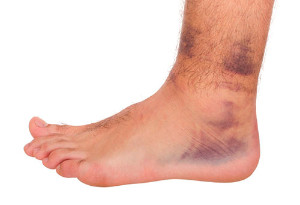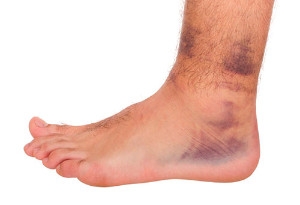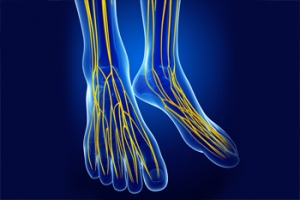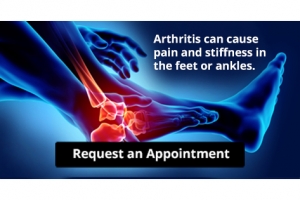Super User
How to Handle a Long Work Day on Your Feet
In 2014, the American Podiatric Medical Association surveyed 1,000 American adults and found that half of all respondents lived with foot pain. Fortunately, there are ways to avoid foot problems such as following a daily footcare routine and wearing proper footwear at work.
If you have a job that requires you to be on your feet, it is best that you do not wear flat sole shoes. Your heel should be slightly elevated (less than 2 inches, but at least ¼-inch) if you are going to be standing for a prolonged period. You should also make sure that the shoes you wear are not too small. Tight shoes may cut off circulation to your feet, which will result in pain and blisters. It is always best to purchase fitted shoes later in the day, because the feet tend to swell as the day progresses. It may also be helpful to buy shoes a half size larger if you plan on wearing custom orthotics or arch supports.
Your muscles may become stiff when you are constantly standing up. It is important to take breaks every hour to stretch and relax. One tip is to perform calf raises, because this exercise will help improve your circulation. To perform this stretch, you first need to stand on the edge of a step with your abdominal muscles pulled inward. You then need to grip the step with the balls of your feet with your heels hanging over the edge. Next, try to raise your heels above the step by a few inches while standing on your tiptoes; hold this pose for a second. You should then lower your heels back even to the platform. These calf raises should be done ten times for full effectiveness.
You should also take care of your feet while you are at home. One of the best ways to prepare your feet for a long day of work is to soak them in ice water. Doing so for 20 minutes will help fight the swelling and inflammation that results from being on your feet at work.
Nevertheless, if you are experiencing pain in your feet, you should seek help from your podiatrist. Your doctor will help treat any ailments you may have in addition to helping you prevent any other ailments from developing in the future.
Are Foot And Ankle Injuries Common?
 The majority of the population has endured a foot or ankle injury at some point in their lives. This type of condition may be prevalent among people who frequently participate in sporting activities. Additionally, muscle mass may decrease in older people, and the bones may become weaker as the aging process occurs. This may lead to falling, and the risk of spraining or fracturing your foot may increase. A stress fracture may occur gradually, and this is typically a result of overuse. A common foot ailment that is referred to as plantar fasciitis can occur when the plantar fascia becomes inflamed. The symptoms that are associated with this condition often consist of severe pain and discomfort in the heel and arch of the foot. If you have a foot or ankle injury, it is strongly suggested that you seek the counsel of a podiatrist who can properly treat any foot conditions.
The majority of the population has endured a foot or ankle injury at some point in their lives. This type of condition may be prevalent among people who frequently participate in sporting activities. Additionally, muscle mass may decrease in older people, and the bones may become weaker as the aging process occurs. This may lead to falling, and the risk of spraining or fracturing your foot may increase. A stress fracture may occur gradually, and this is typically a result of overuse. A common foot ailment that is referred to as plantar fasciitis can occur when the plantar fascia becomes inflamed. The symptoms that are associated with this condition often consist of severe pain and discomfort in the heel and arch of the foot. If you have a foot or ankle injury, it is strongly suggested that you seek the counsel of a podiatrist who can properly treat any foot conditions.
Foot and ankle trauma is common among athletes and the elderly. If you have concerns that you may have experienced trauma to the foot and ankle, consult with one of our podiatrists from Westside Podiatry Center, LLP. Our doctors will assess your condition and provide you with quality foot and ankle treatment.
Foot and ankle trauma cover a range of injuries all over the foot; common injuries include:
- Broken bones
- Muscle strains
- Injuries to the tendons and ligaments
- Stress fractures
Symptoms
Symptoms of foot and ankle injuries vary depending on the injury, but more common ones include:
- Bruising
- Inflammation/ Swelling
- Pain
Diagnosis
To properly diagnose the exact type of injury, podiatrists will conduct a number of different tests. Some of these include sensation and visual tests, X-rays, and MRIs. Medical and family histories will also be taken into account.
Treatment
Once the injury has been diagnosed, the podiatrist can than offer the best treatment options for you. In less severe cases, rest and keeping pressure off the foot may be all that’s necessary. Orthotics, such as a specially made shoes, or immobilization devices, like splints or casts, may be deemed necessary. Finally, if the injury is severe enough, surgery may be necessary.
If you have any questions, please feel free to contact one of our offices located in Liverpool, Camillus, Skaneateles, Oswego, and Cicero, NY . We offer the newest diagnostic and treatment technologies for all your foot care needs.
Foot and Ankle Trauma
The foot and ankle area works with 26 bones, 33 joints, and more than 100 different muscles, tendons, and ligaments. Problems with any parts of this network can result in some kind trauma within the foot and ankle area. Most foot and ankle trauma is a result of aging or intense activities such as sports. However, trauma in this area can also be the result of simple things such as wearing heels too much or even walking on an uneven pavement. There are several kinds of symptoms related to specific injuries, and there are also several different treatments that could be used as well.
Foot Injuries and Symptoms
Some common injuries in the feet include stress fractures and bunions. Stress fractures are small cracks in a bone or severely bruised parts of the bone. This type of injury is caused by intense and repetitive activity, which is found in actions involved with sports and exercise. Symptoms of this injury include pain, swelling, tenderness, and possible bruising. Another common injury with bones is also bunions, which are bony bumps typically formed on the big and little toes. This injury is typically a result from wearing high heels and unfit shoes. Some common symptoms are swelling around the big and little toe areas, as well as pain and restricted movement.
Ankle Injuries and Symptoms
The common injuries associated with ankle trauma consist of sprains, strains, and fractures. These injuries are defined by the type of tissue that has been damaged. Fractures are breaks within the bones caused by sudden impacts to the area. Sprains relate to any damage of the ligaments, commonly caused by being stretched beyond their normal range of motion. Strains are attributed to damage of the muscles and tendons from being pulled too far. Symptoms of these injuries include severe pain, limited range of motion, and swelling.
Diagnosis and Treatment
Since there are several types of injuries with a variety of symptoms, it is important to see a podiatrist about your condition. Podiatrists can run a variety of tests to diagnose an injury accurately. This includes physical examinations, X-rays, or MRIs. A podiatrist may even run a stress test, which is an X-ray taken while pressure is applied to the damaged area. Once your injury has been diagnosed, the doctor may have you wear a cast or a splint, or gradually develop your range of motion. Severe injuries may require physical therapy or even surgery if necessary. If you have any concerns from past foot and ankle trauma experiences, consult with one of our podiatrists from Westside Podiatry Center, LLP. Our doctors can assess your condition and provide you with quality foot and ankle treatment.
If you have any questions, please feel free to contact one of our offices located in Liverpool, Camillus, Skaneateles, Oswego, . We offer the newest diagnostic and treatment technologies for all your foot care needs.
Are You Suffering From Ingrown Toenails?
Are Bunions Affecting Your Everyday Life?
How to Handle Poor Foot Circulation
 Those who are living with diabetes may be more likely to experience poor circulation in their feet. Poor circulation can lead to a number of foot complications including neuropathy and peripheral artery disease. There are, however, a few things you can do to better prevent poor circulation. Resisting smoking is a good way to reduce your likelihood of having poor circulation, since smoking makes arteries harden faster. Maintaining healthy blood pressure and cholesterol levels may also assist in reducing poor circulation. It is additionally recommended to practice an exercise routine, as exercise helps to stimulate blood flow. Because poor circulation can lead to more severe foot complications, it is recommended that you consult with a podiatrist for a proper diagnosis and advice on treatment options.
Those who are living with diabetes may be more likely to experience poor circulation in their feet. Poor circulation can lead to a number of foot complications including neuropathy and peripheral artery disease. There are, however, a few things you can do to better prevent poor circulation. Resisting smoking is a good way to reduce your likelihood of having poor circulation, since smoking makes arteries harden faster. Maintaining healthy blood pressure and cholesterol levels may also assist in reducing poor circulation. It is additionally recommended to practice an exercise routine, as exercise helps to stimulate blood flow. Because poor circulation can lead to more severe foot complications, it is recommended that you consult with a podiatrist for a proper diagnosis and advice on treatment options.
Poor circulation is a serious condition and needs immediate medical attention. If you have any concerns with poor circulation in your feet contact one of our podiatrists of Westside Podiatry Center, LLP. Our doctors will treat your foot and ankle needs.
Poor Circulation in the Feet
Poor blood circulation in the feet and legs is can be caused by peripheral artery disease (PAD), which is the result of a buildup of plaque in the arteries.
Plaque buildup or atherosclerosis results from excess calcium and cholesterol in the bloodstream. This can restrict the amount of blood which can flow through the arteries. Poor blood circulation in the feet and legs are sometimes caused by inflammation in the blood vessels, known as vasculitis.
Causes
Lack of oxygen and oxygen from poor blood circulation restricts muscle growth and development. It can also cause:
- Muscle pain, stiffness, or weakness
- Numbness or cramping in the legs
- Skin discoloration
- Slower nail & hair growth
- Erectile dysfunction
Those who have diabetes or smoke are at greatest risk for poor circulation, as are those who are over 50. If you have poor circulation in the feet and legs it may be caused by PAD and is important to make changes to your lifestyle in order to reduce risk of getting a heart attack or stroke. Exercise and maintaining a healthy lifestyle will dramatically improve conditions.
As always, see a podiatrist as he or she will assist in finding a regimen that suits you. A podiatrist can also prescribe you any needed medication.
If you have any questions please feel free to contact one of our offices located in Liverpool, Camillus, Skaneateles, Oswego, and Cicero, NY . We offer the newest diagnostic and treatment technologies for all your foot and ankle needs.
Causes, Symptoms, and Treatment of Poor Blood Circulation in the Feet
Poor blood circulation in the feet and legs is often caused by peripheral artery disease (PAD), which is usually the result of a buildup of plaque in the arteries. Plaque buildup, or atherosclerosis, can be the result of excess calcium and cholesterol in the bloodstream. This restricts how much blood can flow through arteries. Reduced blood flow to a certain area of the body severely limits the amount of oxygen and nutrients that part of the body receives. This leads to degeneration in the muscles and other tissues. Sometimes, poor blood circulation in the feet and legs can be caused by other conditions, such as the damaging or inflammation of blood vessels, known as vasculitis.
The lack of oxygen and nutrients caused by poor blood circulation can restrict muscle growth and development, as well as cause muscle pain and cramps, weakness, and stiffness. Other common symptoms include numbness in the legs and feet, skin discoloration in the affected limbs, slower nail and hair growth, and erectile dysfunction in men. In more severe cases of PAD, pain can be present even when a person isn't exercising, and may range from mildly uncomfortable to completely debilitating.
Poor blood circulation in the feet and legs is more common in those who are overweight or obese, have diabetes, high blood pressure, high cholesterol, who smoke, or who have a family history of PAD or related conditions such as a heart attack, stroke, etc. Diabetes and smoking place a person at greatest risk for developing poor blood circulation, although advanced age, over 50, can also increase risk.
If you are experiencing poor blood circulation in the feet and legs caused by PAD, it is important to make changes to your lifestyle in order to reduce your risk of experiencing a heart attack or stroke caused by this condition. If you smoke, quit completely. This will increase the amount of oxygen in your bloodstream. Exercising and reducing the saturated fats in your diet. Saturated fats come from fatty meats, fried foods, whole milk, etc., can make a difference in improving blood circulation in feet. It is also important to avoid developing influenza and to carefully control your blood sugar if you have diabetes.
Your doctor may recommend combining lifestyle changes with a prescription medication regimen to improve blood circulation. The most commonly-used medications for PAD are called statins and work by blocking the amount of enzymes in your body that produce cholesterol. They are known by the brand names Zocor, Lipitor, Crestor, and others.
Arthritis Can Cause Pain in the Feet and Ankles
Reducing the Symptoms of Gout
 Arthritis can affect a person in many different ways. One form of inflammatory arthritis is known as gout, which may often cause issues for the toes, specifically the big toe. Gout typically develops due to a buildup of uric acid when the body tries to break down purines found in foods. Dietary changes may be effective in reducing purine levels as well as the likelihood of a gout flare up. Drinking a lot of water may help with the swelling and inflammation that is often caused by gout. Another method of reducing gout-related inflammation, is by icing the affected joints and keeping the feet elevated. As far as reducing your purine levels, it’s advised that you avoid meats and fish such as bacon, turkey, scallops, and muscles, to name a few. For more advice on how to manage your gout, we recommend that you consult with a podiatrist for professional care.
Arthritis can affect a person in many different ways. One form of inflammatory arthritis is known as gout, which may often cause issues for the toes, specifically the big toe. Gout typically develops due to a buildup of uric acid when the body tries to break down purines found in foods. Dietary changes may be effective in reducing purine levels as well as the likelihood of a gout flare up. Drinking a lot of water may help with the swelling and inflammation that is often caused by gout. Another method of reducing gout-related inflammation, is by icing the affected joints and keeping the feet elevated. As far as reducing your purine levels, it’s advised that you avoid meats and fish such as bacon, turkey, scallops, and muscles, to name a few. For more advice on how to manage your gout, we recommend that you consult with a podiatrist for professional care.
Gout is a painful condition that can be treated. If you are seeking treatment, contact one of our podiatrists from Westside Podiatry Center, LLP. Our doctors will treat your foot and ankle needs.
What Is Gout?
Gout is a form of arthritis that is characterized by sudden, severe attacks of pain, redness, and tenderness in the joints. The condition usually affects the joint at the base of the big toe. A gout attack can occur at any random time, such as the middle of the night while you are asleep.
Symptoms
- Intense Joint Pain - Usually around the large joint of your big toe, and it most severe within the first four to twelve hours
- Lingering Discomfort - Joint discomfort may last from a few days to a few weeks
- Inflammation and Redness -Affected joints may become swollen, tender, warm and red
- Limited Range of Motion - May experience a decrease in joint mobility
Risk Factors
- Genetics - If family members have gout, you’re more likely to have it
- Medications - Diuretic medications can raise uric acid levels
- Gender/Age - Gout is more common in men until the age of 60. It is believed that estrogen protects women until that point
- Diet - Eating red meat and shellfish increases your risk
- Alcohol - Having more than two alcoholic drinks per day increases your risk
- Obesity - Obese people are at a higher risk for gout
Prior to visiting your podiatrist to receive treatment for gout, there are a few things you should do beforehand. If you have gout you should write down your symptoms--including when they started and how often you experience them, important medical information you may have, and any questions you may have. Writing down these three things will help your podiatrist in assessing your specific situation so that he or she may provide the best route of treatment for you.
If you have any questions, please feel free to contact one of our offices located in Liverpool, Camillus, Skaneateles, Oswego, and Cicero, NY . We offer the newest diagnostic and treatment technologies for all your foot care needs.











